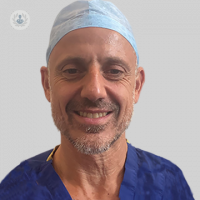Lumbar decompression: how it works, what it’s for, recovery time
Written by:Lumbar decompression is a surgical operation to create more space for your nerves and spinal cord. There are many different ways a lumbar decompression can be carried out depending on your condition. This article by leading neurosurgeon Mr Sinan Barazi looks at how the procedure works, who it’s for, and what to expect after the operation.

Why do I need lumbar decompression surgery?
Lumbar decompression surgery aims to free up space for your spinal cord and relieve pressure on your nerves. Pressure on the nerves can cause serious symptoms such as:
- pain (sciatica)
- difficulty walking
- weakness in the legs
These symptoms can arise due to a slipped disc or an age-related condition such as spinal stenosis.
These conditions are initially treated with conservative techniques such as medication and physiotherapy. However, if this has not been successful in treating the symptoms described above, your doctor may recommend lumbar decompression surgery.
In rare cases, a compressed spine can interfere with your bladder or bowel function, and emergency spinal surgery is required.
How does lumbar decompression surgery work?
Lumbar decompression surgeon involves getting access to your spine and removing some bone and tissue to take some pressure away from the affected area. It is performed under general anaesthetic.
To access the spine, the surgeon will make a small incision and locate the correct level of the spine guided by an X-ray. This might involve moving some muscles out of the way but these will be stitched together again afterwards.
We have a number of ways to reduce the pressure on the nerves and spinal cord. Your doctor might use the following terms:
Laminotomy
This is a procedure to remove part of the lamina. The lamina is an inside arch of the vertebral bone, and two laminae make up the back wall of the vertebra. A laminotomy usually removes part of just one lamina, and can be performed using open-access or minimally-invasive techniques.
Laminectomy
This removes the entire lamina, in cases of severe decompression
Discectomy
This is an operation to remove the bulging part of a herniated disc, and can also be performed with open-access or minimally-invasive techniques (also known as a microdiscectomy). To access the herniated disc the surgeon will also remove a small part of ligament in the spine and a tiny bit of bone, freeing the nerve root.
Foraminotomy
This is a procedure that increases the space where a nerve root exits the spinal canal. Every vertebra in your spine has two openings called neuroforamen, and when these spaces become to small these nerves can become pinched. A foraminotomy involves removing whatever is causing the compression – whether it is a herniated disc or a bone spur.
What to expect after the operation
After the operation you’ll stay in hospital overnight so that if any complications arise they can be dealt with quickly. Before you leave the hospital you’ll be given advice on exercise to build up your back muscles again and stay mobilised.
You should have another consultation after about 6-8 weeks to assess your overall progress.
If you are struggling with back pain or weakness in your legs, book a consultation with Mr Sinan Barazi.


